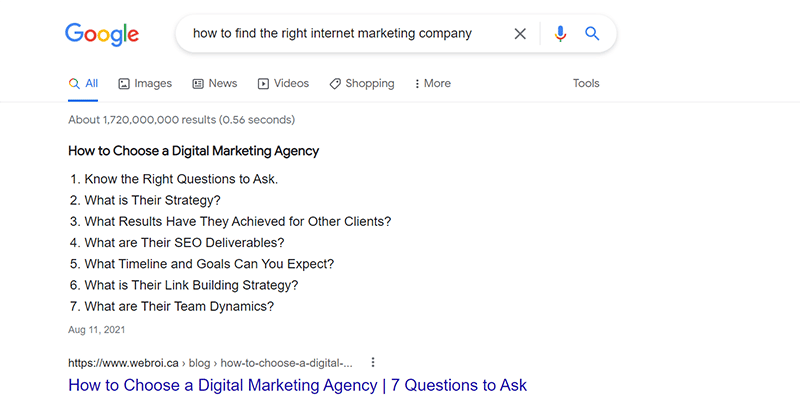Top 10 SEO Questions & Answers
Whether you’re new to SEO or looking to fine-tune your strategy, it’s important you understand how search engines find content and what best practices you should use to maximize your rankings.
Below, we answer 10 of the most common questions about SEO.
Table of Contents:
- What is SEO?
- How Long Does it Take for SEO to Show Results?
- What is On-page SEO?
- What is SEO content?
- What Are Examples of SEO Content?
- What is Duplicate Content in SEO?
- What is Metadata in SEO?
- How Do You Optimize Images For SEO?
- What is a Google Featured Snippet?
- What Are The Top SEO Tools to Use?
1. What is SEO?
SEO stands for "search engine optimization", which is the process of improving your webpage’s visibility within search results. Essentially, SEO is the act of targeting search engines, like Google and Bing, so that your website shows up first when users search terms related to the content on your pages.
When a user enters a query into a search engine, the search engine applies computational algorithms to determine which results are most relevant. By optimizing your web content to meet the algorithms’ criteria for high-ranking results, you increase your chances of coming up on the first page, and therefore, the likelihood of users clicking your link.
2. How Long Does it Take for SEO to Show Results?
As with anything worth pursuing, it takes time to reap the benefits of an effective SEO strategy. Generally, the time it takes to see results depends on a few factors, such as:
- The resources you are willing to allocate.
- How much competition you are up against.
- The keywords you are targeting.
Typically, you can expect to see results within 6-12 months of implementing your SEO strategy. However, keep in mind that ranking high with Google will not happen without effort. You must work on your strategy consistently, making tweaks when needed to continue improving your rankings.
The good news is that all this effort will pay off once you start ranking high in search results.
3. What is On-page SEO?
On-page SEO (also known as on-site SEO) is a component of SEO strategy that focuses on optimizing aspects of a webpage, including:
- Meta description
- Title tags
- Header tags
- URL optimization
- Alt tags
- Page content
In contrast, there is also off-page SEO, which centres around aspects found outside of your website including influencer marketing, citation building and your social media presence.
Together, both on-page and off-page SEO work in synergy to improve your brand’s visibility and help you find success in the long run.
4. What Is SEO Content?
SEO content is useful, compelling, and high-quality content that targets specific keywords and provides helpful answers to commonly searched questions or problems. By posting valuable SEO content, you’ll help boost your brand’s authority all while improving your site’s search engine rankings.
To rank high with your SEO content, make sure you are writing content that is relevant to your target keywords. It is also extremely important that you remember to write for people and never just the algorithm. This includes writing naturally while implementing keywords that fit the context.
5. What Are Examples of SEO Content?
There are several types of content that can be used to target search engines. Here, we list a few of the most common examples:
- Products Pages: Vital for any retail e-commerce site, product pages are both informative and persuasive. With proper SEO keywords used throughout the content, a product page can help you rank high while also serving as a PPC landing page.
- Blog Posts: Uploading regular blog posts is one of the easiest ways to establish a consistent stream of SEO content. As long as the blog posts are engaging and relevant, they may provide more link click-throughs than product pages.
- Articles: This includes news articles, case studies or any type of featured piece.
- Lists: Lists are like articles but are instead formatted as a list of items with a captivating title that reads something like “The Top 5 Home Décor Trends This Summer”. Generally, these types of titles are more likely to get clicked on when found in searches or on social media.
- Guides: Guides are a type of long-form content that explains a topic or process in detail. Guides can be posted in full on your website or as a summary with a prompt requiring visitors to complete an action before gaining access to the whole guide.
- Videos: Posting written content isn’t the only way to rank high. Videos are an engaging form of media and can share the same information found in a blog post or guide. A video can even help you rank higher with more competitive keywords.
- Infographics: As the name suggests, these are graphics or images that contain information about a certain subject. To utilize these for SEO, make sure the page they’re on is optimized as well as the alt text since the content on the image is usually embedded.
6. What is Duplicate Content in SEO?
Copied Content vs. Duplicate Content
Copied content is any content that has been copied from another domain.
On the other hand, duplicate content is content that originates from your domain but is found on multiple pages of your website.
Unlike with copied content, you won’t be penalized for duplicating content on your site. However, duplicate content may impact your SEO strategy since you are not taking advantage of the SEO opportunities provided by each unique page. To add, duplicate content is filtered through Google, so it's not guaranteed that your content will be seen.
7. What is Metadata in SEO?
Metadata is data that provides information about other data on your site but not the content itself. In SEO, a type of metadata element called meta tags tells search engines key information about your site and its pages. Overall, meta tags can have an enormous impact on your search engine ranking and your click-through rate, so it is important you don’t overlook them.
When you use each tag effectively, you improve user experience and make Google’s job easier at the same time. The following are the different tags you should use on your website:
- Title Tags
- Descriptions
- ALT Tags
8. How Do You Optimize Images For SEO?
Again, it’s not just written content that needs to target search engines. Images can also be optimized to improve your search result rankings. Below we outline some steps you can take to optimize images:
- Ensure your images load quickly. Keep in mind that a web image should be 72 dpi and not 300 dpi, which is standard for print.
- Search engines can’t look at images, but they can read the associated ALT tag. Make sure you include descriptive SEO keywords in your alt image text—but don’t overdo it. The content should always sound natural.
- Place images inside proper folders that tell you what's there like "images" or something similar. The final URL of the image should read something like this: /images/image.jpg
9. What is a Google Featured Snippet?
A featured snippet is an excerpt of text found near the top of Google's search results. These snippets provide users with a short summary of the page or a quick answer to their question. Google's search algorithm chooses to highlight content that contains the most relevant information related to a user's search.
Since it's shown in the coveted "position 0" on Google, it's easy to see why getting a featured snippet can have a massive impact on your site's visibility.

What Are The Top SEO Tools to Use?
SEO is a complicated field that takes years to learn. Luckily though, you don’t have to be an expert in it to reap the rewards of SEO. Below, we list some of the best SEO software tools available to help you rank higher in search results.
1. Screaming Frog SEO Spider
Screaming Frog SEO Spider is a desktop-based SEO tool that acts as a web crawler to help you improve on-page SEO. This tool helps you detect broken links, analyze metadata, discover duplicate content, and more.
2. Semrush Keyword Magic Tool
This simple keyword research tool is popular for a reason. Semrush provides users with the relevant and up-to-date keywords needed to have an effective SEO campaign.
3. Google PageSpeed Insights
PageSpeed Insights is a fantastic way to stay on top of your SEO. This tool helps you locate issues with your website so you can continue to optimize your content.
Get Professional SEO Advice
Want to learn more about SEO? At WEB ROI, we can help you get the most out of your SEO investments. Get in touch today!

